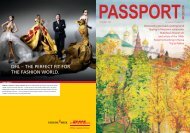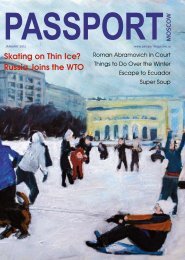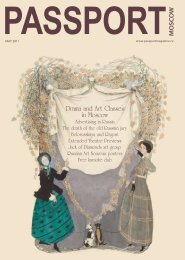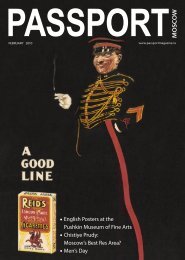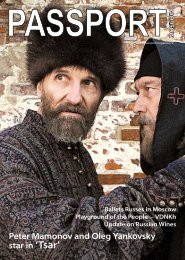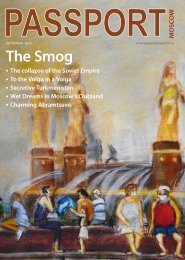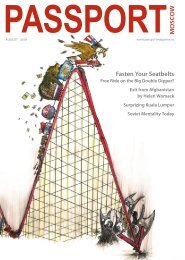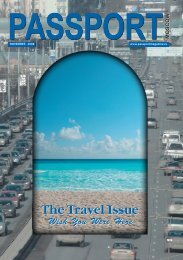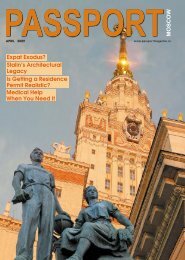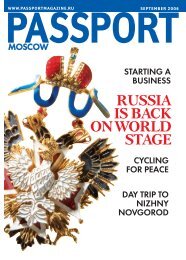M O S C O W Interview with Leonid Shishkin - Passport magazine
M O S C O W Interview with Leonid Shishkin - Passport magazine
M O S C O W Interview with Leonid Shishkin - Passport magazine
Create successful ePaper yourself
Turn your PDF publications into a flip-book with our unique Google optimized e-Paper software.
Russian Reflections<br />
Was Alaska<br />
sold for a<br />
song?<br />
It is customary to consider that the USA bought Alaska<br />
together <strong>with</strong> adjacent, islands <strong>with</strong> overall area of 1.5<br />
million square kilometres for $7.2m in gold, which works out<br />
as about 2c per acre. These figures are printed in Russian<br />
and American literature as well as in various atlases.<br />
But was there a sale at all, or was it more like the USA<br />
paid Russia so that it would finally leave the American<br />
continent? In the first part of a two-part series, Yury<br />
Samoilov takes us back to the mid-eighteenth century<br />
when fur-hungry Russia colonised Alaska.<br />
Yury Samoilov<br />
The Russian-American<br />
Fur rush<br />
Company<br />
For local residents of the Chukotka-pen- To hold back foreign competitors,<br />
insula, Russian-Alaska was a place they Russian hunters decided to unite their<br />
had known about for a long time. They efforts, and in 1799 set up a powerful<br />
regularly rode there on sleighs pulled by monopoly <strong>with</strong> the name “Russiandeer<br />
across the Bering Strait in the winter American Company” or RAC. The com-<br />
and on boats in the summer to exchange pany was a joint-stock company found-<br />
goods <strong>with</strong> natives of Alaska.<br />
ed solely <strong>with</strong> Russian capital.<br />
Such journeys took a single day. In- The tsarist elite, having benefitted<br />
tensive colonization of Alaska began greatly in monetary terms from RAC,<br />
only after Russian seamen, Vitus Bering not only acquired part of the company’s<br />
and Alex Chirickov, reached the Ameri- stocks, but decided to make use of it for<br />
can continent in the summer of 1741<br />
on the three-masted sailing ships, Saint<br />
Peter and Saint Pavel. Tales of a huge<br />
number of fearless fur-bearing animals<br />
wandering along the shores who were<br />
not afraid of human beings got Russian<br />
hunters excited. Disregarding the<br />
risks involved, they rushed to the new,<br />
unknown lands, set up fortified settlements,<br />
showing no mercy on animals<br />
or natives. A mass extermination of sea<br />
otters, the pelts of which were highly<br />
valued on world market, and other wild<br />
animals was started.<br />
After a few years, American and British<br />
hunters joined in, enraging local Indians<br />
who mounted many, mostly unsuccess-<br />
Novo-Arkhangelsk. Drawing by I. G. Vosnesensky<br />
ful, rebellions against the aliens.<br />
2 June 2010<br />
Alexander Baranov<br />
the expansion of the Russian Empire.<br />
The first governor of Russian colonies in<br />
Alaska was Aleksander Baranov, a merchant<br />
from the small Russian town Kargopol.<br />
One of his descendants, Zoja Afrosina who is<br />
alive today, found out quite accidentally about<br />
her kinship <strong>with</strong> her eminent ancestor. She was<br />
informed that her uncle (a relative of Baranov),<br />
had left her heritage. She discovered a large<br />
number of previously unknown documents,<br />
concerning Baranov’s private life. He apparent-<br />
by the author



